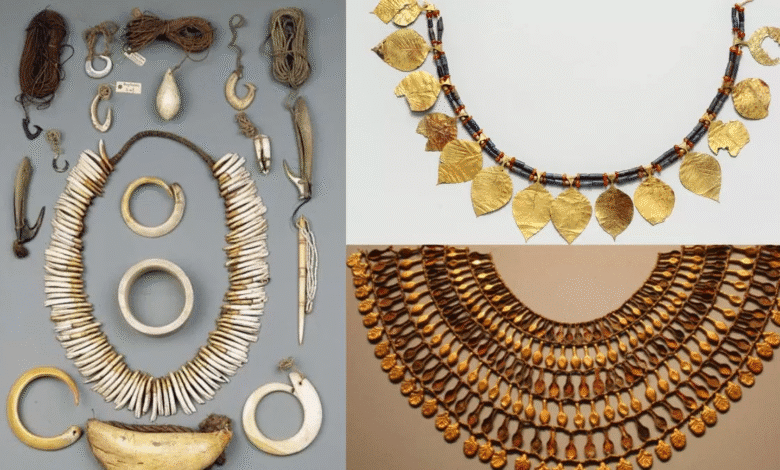Necklaces Through History: A Look at Timeless Adornments

Necklaces have long been a symbol of beauty, power, and status. Throughout history, they have evolved in style, materials, and significance, transcending cultures and periods. From ancient civilizations to the modern-day fashion world, necklaces have always held a special place in the hearts of people worldwide. Explores the fascinating journey of necklaces, offering a glimpse into their historical significance and enduring appeal.
The Origins of Necklaces in Ancient Times
Ancient Egypt: A Symbol of Power and Spirituality
In ancient Egypt, necklaces were much more than just decorative items; they held deep symbolic meanings. Pharaohs and high-ranking officials wore elaborate necklaces made of gold, precious stones, and intricate designs. These necklaces often represented power, divinity, and protection. One of the most iconic examples is the Egyptian collar necklace, known as the “week,” which was often adorned with amulets and charms believed to offer protection in the afterlife.
Mesopotamia and Ancient Persia: Opulence and Craftsmanship
In Mesopotamia and Ancient Persia, necklaces were crafted using beads, gemstones, and metals such as gold and silver. These civilizations were known for their incredible craftsmanship and the use of elaborate, ornate designs. Necklaces in these regions were a symbol of wealth and status, often passed down through generations as family heirlooms.
Ancient Greece and Rome: Elegance and Mythology
The ancient Greeks and Romans embraced necklaces as a way to express their connection to the gods and goddesses. Jewelry designs were often inspired by nature and mythology, with motifs like leaves, birds, and mythical creatures. Gold, pearls, and colorful gemstones adorned their necklaces, making them popular among the elite. In Greek culture, necklaces were also worn as offerings to the gods, highlighting their spiritual significance.
The Middle Ages: A Shift in Necklace Design
Medieval Europe: Religious and Royal Influence
During the Middle Ages, necklaces took on a more religious and royal meaning in Europe. The designs became less elaborate than those of ancient civilizations, focusing instead on symbols of faith and power. Twofold cross necklace were commonly worn by Christian believers, while royalty and nobility displayed their wealth through pearl necklaces and other precious gems.
Renaissance Period: The Revival of Artistic Expression
The Renaissance period saw a resurgence of creativity and artistic expression, and necklaces became more extravagant. Goldsmiths and artisans created intricate designs, often featuring religious imagery, coats of arms, and portraits. This era also introduced new materials, such as diamonds, into necklace designs, with necklaces becoming more of a personal and artistic statement than a religious or political one.
The Modern Era: Fashion and Individuality
Victorian Era: Sentimental Jewelry
The Victorian era brought about a new meaning to necklaces—sentimental jewelry. Necklaces became keepsakes, with lockets, cameos, and hair jewelry becoming increasingly popular. Many necklaces from this period included mementos of loved ones, such as locks of hair or miniature portraits, emphasizing the importance of personal sentiment in jewelry design.
Art Deco and Modernism: Bold and Geometric Designs
In the early 20th century, the Art Deco movement revolutionized necklace design with bold, geometric shapes, vibrant colors, and the use of modern materials like platinum. These designs were sleek, and fashionable, and symbolized the technological advancements of the time. Necklaces from this era reflected the changing roles of women in society, with shorter, statement pieces that complemented the flapper dresses and modern fashion trends of the Roaring Twenties.
Contemporary Fashion: A Blend of Tradition and Innovation
Today, necklaces continue to be a versatile and timeless accessory. Designers blend tradition with innovation, using both classic materials like gold and silver and incorporating modern elements such as synthetic gemstones and sustainable materials. Necklaces range from minimalist chains to bold, statement pieces, catering to a wide array of personal styles and preferences.
Necklaces in Cultural Traditions
Indian Jewelry: A Rich Cultural Heritage
Necklaces have always played a significant role in Indian culture, with gold necklaces being a symbol of prosperity and status. Indian brides, for example, often wear elaborate gold necklaces as part of their wedding attire, representing the family’s wealth and the bond of marriage. Traditional Indian necklaces, such as the “mangalsutra,” hold deep cultural and religious significance and are often passed down through generations.
African Necklaces: Connection to Community and Identity
In many African cultures, necklaces are deeply tied to community, identity, and tradition. They are often made from natural materials like beads, shells, and bones, with specific colors and patterns symbolizing various aspects of life, such as status, age, or achievements. The Maasai people of East Africa, for instance, are known for their vibrant, colorful beadwork, with each necklace design telling a unique story.
The Timeless Appeal of Necklaces
Necklaces have stood the test of time because of their adaptability and ability to convey meaning beyond their aesthetic appeal. Whether used to symbolize status, spirituality, love, or personal style, necklaces remain one of the most cherished forms of adornment.
Conclusion
From ancient Egypt’s collars to the intricate pendants of the Victorian era, necklaces have continued to evolve, yet their essence remains unchanged. They are more than just a fashion statement; they are pieces of history, culture, and personal expression. As we move forward, the necklace will undoubtedly continue to be a timeless and meaningful adornment in the world of fashion and beyond.